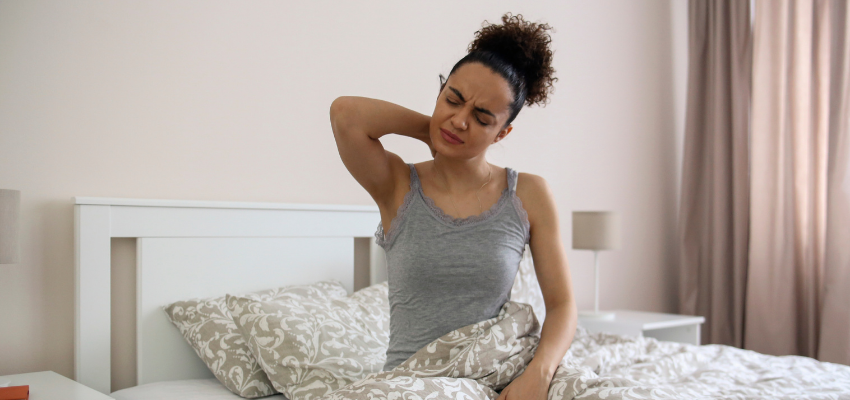Getting a good night’s sleep isn’t just about the number of hours you spend in bed — it’s also about how you sleep and whether your neck is duly supported. Poor sleeping positions or inadequate neck support can lead to stiffness, pressure headaches, and long-term posture issues. For individuals who are already dealing with discomfort, choosing the right neck support becomes indeed more essential.
In this blog, we’ll inspect how different sleeping positions affect your neck, the importance of proper neck support for alleviating neck pain, and solutions such as pillows, sleeping techniques, and therapeutic devices like a posture neck pump.
Why Neck Support Matters during Sleeping
Your neck contains delicate structures, muscles, ligaments, discs, and joints that work together to support the weight of your head and maintain alignment. At night, these structures rely on external support since your muscles relax during sleep. Without proper neck pain support, you may wake up with stiffness, soreness, or indeed habitual pain.
Good neck support helps:
- Keep the cervical spine in an impartial position
- Reduce strain on muscles and ligaments
- Improve breathing and circulation
- Enhance overall sleep quality
When your neck is damaged, the consequences may extend beyond discomfort. Over time, poor posture during sleeping can contribute to long-term chronic problems and reduced mobility.
The Connection Between Sleeping Position and Neck Health
Your sleeping position plays a critical role in how much stress is placed on your neck. Let’s break down the most common positions and their effect on cervical alignment.
1. Back Sleeping (Supine Position)
Sleeping on your right side is generally considered the healthiest position for spinal alignment. With the right neck support pillow, your head, neck, and chin remain neutral. Still, a pillow that’s too thick or too thin can cock the head constitutionally, leading to pressure.
Best Tips: Use a medium-consistency pillow or memory froth designed to grip the neck. Pairing this with a posture neck pump session before bed can help relax muscles and prepare your cervical chine for rest.
2. Side Sleeping
Side sleeping is the most common position. While it helps reduce snoring and acid reflux, it can cause neck strain if the pillow doesn’t fill the gap between the head and shoulders. Proper neck pain support is vital here.
Best tip: Use a firm pillow with good loft and minimal height. to keep the head aligned with the spine. Body pillows can also prevent twisting during sleep.
3. Stomach Sleeping
This is the least recommended position because it forces the head to turn sideways, twisting the neck for hours at a time. This frequently results in stiffness, headaches, and, indeed, whim-wham contraction.
Best tips: If you can not avoid this position, use the thinnest pillow possible or none at all to minimize strain.
Types of Neck Support for Better Sleep
Choosing the right neck support for neck pain often comes down to selecting the right pillow or device. Here are the most effective options:
1. Memory Foam Pillows
These pillows contour to the natural curve of your neck, providing personalized support. They are especially helpful for individuals with chronic stiffness.
2. Cervical Pillows
Designed with a central cavity, cervical pillows cradle the head while supporting the neck. They’re often recommended for people recovering from neck injuries.
3. Adjustable Pillows
Filled with shredded memory foam, buckwheat, or microbeads, these pillows allow you to customize height and firmness—ideal for both side and back sleepers.
4. Posture Neck Pump Devices
A neck pump is not a pillow. A neck pump is a reshaping device that gently stretches and relaxes the natural curve of the cervical spine. Additionally, using it pre-sleep decreases pressure and improves posture, making it a wonderful adjunct to some other forms of neck-pain relief.
How Poor Neck Support Affects Your Health
Disregarding adequate neck support can result in several categories of problems, including
- Stiffness in the morning: Muscles are likely to stay tense throughout your sleep.
- Chronic headaches: Poor circulation due to misalignment is usually the cause of tension headaches.
- Posture deterioration: Usually, over time, sleeping in a dysfunctional position will lead to forward head posture.
- Irritated nerves: Misalignment may compress the cervical nerves, causing neuropathy such as numbness or tingling.
If you consistently wake up with soreness, it may be time to reassess both your pillow and your sleeping position.

Tips for Choosing the Best Neck Support for Neck Pain
Select appropriate pillow loft according to sleeping position: Back sleepers require medium loft; side sleepers require high loft; stomach sleepers require very low loft.
- Choose a supportive material: Memory foam and latex can provide firm but comfortable support.
- Check for proper spinal alignment: Your head should not tilt forward, backward, or sideways while you are at rest.
- Consider pads, pillows, or devices: If pain persists, a posture neck pump can be used to restore spinal alignment.
- Replace pillows as they age: Old pillows become unsupportive over time. Ideally, pillows should be replaced every 1-2 years.
Daily Habits That Complement Neck Support
Even with the best pillow, daily posture habits affect how your neck feels at night. To maximize the benefits of neck pain support, integrate these habits:
- Practice good desk posture: Keep screens at eye level to avoid forward head posture.
- Stretch before bed: Gentle neck stretches relax muscles.
- Use a posture neck pump: Five to ten minutes daily can improve cervical curvature.
- Stay active: Regular exercise strengthens supportive muscles around the spine.
When to Seek Professional Help
Sometimes, no amount of pillow adjustment can fully resolve neck pain. If you experience any of the following, consult a doctor or physical therapist:
- Persistent pain lasting more than a few weeks
- Numbness, tingling, or weakness in the arms
- Frequent migraines linked to neck tension
- Difficulty turning your head fully
A healthcare professional may suggest you physical therapy, chiropractic care, or specific devices like a posture neck pump to address underlying issues.
Final Thoughts
To improve the quality of your sleep, it starts with alignment. Having sufficient support for your neck, whether it is through a pillow, a therapeutic device, or daily postural habits, will improve overall comfort and contribute to health in the long run. Selecting the right pillow based on your sleeping position, using a posture neck pump before going to bed, and working on healthy posture during the day will assist in avoiding stiffness and chronic pain.
If you are experiencing ongoing pain or discomfort, remember: the goal of investing in proper neck support for neck pain is not just about getting better sleep, but also the protection of your spine, posture, and overall health.
FAQs
1. What is the way to sleeping position for neck support?
Back sleeping with a medium-support pillow is ideal, but side sleeping can also be healthy with proper pillow height.
2. How can I reduce neck pain from sleeping wrong?
Use a supportive pillow, practice stretching, and consider a posture neck pump to realign your spine.
3. Can the wrong pillow be the main issue in chronic neck pain?
Yes. Poor pillows lead to misalignment, which may result in long-term stiffness and pain.
4. Are posture neck pumps safe for daily use?
When used as directed, posture neck pumps are safe and effective for improving cervical posture and reducing pain.
5. How often should I replace my pillow for proper neck support?
Every 1–2 years, depending on wear and material.
6. Do I need different pillows for different sleeping positions?
Yes. Pillow loft and firmness should match whether you sleep on your back, side, or stomach.








